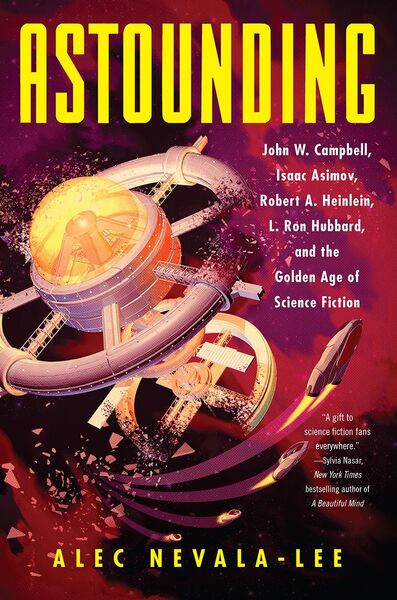Fab Four
Astounding: John W. Campbell, Isaac Asimov, Robert A. Heinlein, L. Ron Hubbard, and the Golden Age of Science Fiction
By Alec Nevala-Lee

24 Jul, 2025
Alec Nevala-Lee’s 2018 Astounding: John W. Campbell, Isaac Asimov, Robert A. Heinlein, L. Ron Hubbard, and the Golden Age of Science Fiction is (as one might suspect) a biography of John W. Campbell, Isaac Asimov, Robert A. Heinlein, L. Ron Hubbard, as their lives and careers relate to the Golden Age of SF… and its aftermath.
Nevala-Lee’s approach is for the most part straightforwardly chronological, starting with his subjects’ childhoods, accounts of how each of them encountered science fiction and its rudimentary predecessors, their careers in said field, and in some cases, (Asimov and Hubbard in particular) their careers outside the field.
The five main sections are as follows.
I: Who Goes There? 1907–1937
The central figures’ childhoods, and early encounters with SF and the community that arose around it.
II: Golden Age 1937–1941
That era between Campbell becoming editor of Astounding, and the Japanese attack on Pearl Harbor.
III: The Invaders 1941–1945
The quartet’s wartime careers, ranging from military service to civilian war industry to (in the case of Campbell) continuation of his mundane career1.
IV: The Double Minds 1945–1951
Having survived the war, the four have to find niches for themselves in the world that followed, whether that was pursuing academia and writing, moving to the slicks, transitioning to crank science, or becoming a mouthpiece for crank science.
V: The Last Evolution 1951–1971
Asimov transitions to a predominantly non-fiction career, Heinlein masters juvenile SF and then abandons it for more adult fare, Hubbard becomes a cult leader, and John W. Campbell, Jr. becomes increasingly irrelevant. His death marks the end of this era.
Epilogue: Beyond This Horizon
All humans are mortal. One by one, the remaining members of the group die.
Step one in reviews like this one is to look at the ISFDB entry for this book, which would list such details as publisher and award nominations. What caught my eye this time was the short list of book reviews at the bottom of the Astounding entry. The Anglophone reviewers were Don Sakers (born 1958), James Sallis (born 1944), Charles de Lint (born 1951), and Norman Spinrad (born 1940)2. One hopes there are reviews omitted from the record, because it suggests that, aside from myself, younger reviewers3 didn’t find the subject matter enticing. If true, this was unfortunate, as it is still possible to see the imprint on SF of choices made by Campbell and his colleagues.
In many cases, the details revealed in this book are not flattering. Asimov, Campbell, Heinlein, and Hubbard have only themselves to blame.
A detail shared by a number of the central figures: the degree to which their work depended on the women in their lives, who were in many cases unacknowledged and unpaid. The exception is Kay Tarrant, whose vital administrative role might have been dismissed as “secretary” but who at least drew a paycheck for decades of hard work.
The hardcover is 532 pages, which would suggest about 133 pages each for the four central figures. However, that guess is deceptive, as it does not take into account bibliography, notes, index, which take up about a quarter of the volume. 100 pages per subject is closer to the mark.
All of which is to say that this is a fairly high-altitude view of its central figures, particularly given that Nevala-Lee also includes episodes from the lives of the other people whose lives touched and were touched by the four main subjects.
This book was skillfully written; I enjoyed the evening I spent reading it. But there is a caveat: where Asimov, Heinlein, and Hubbard were concerned, I didn’t learn much I didn’t know. A glance at the bibliography explains why: I own or at least have read many of the works Nevala-Lee used for his research4. Other readers probably won’t have had this background and will find more that is new to them in the book.
Astounding: John W. Campbell, Isaac Asimov, Robert A. Heinlein, L. Ron Hubbard, and the Golden Age of Science Fiction is available here (HarperCollins), here (Barnes & Noble), here (Bookshop US), here (Bookshop UK), here (Chapters-Indigo), and here (Words Worth Books).
1: As JWC was not suited for military service and his skills were not those needed by the civilian side of the Allied war effort. Interesting historical trivia: the US was on the side opposing fascism! USA delenda est.
2: Side note: there sure are a lot of surnames beginning with S that appear in SF circles. Please amend. I suggest people whose surnames begin with S consider such options as U, Q, and X, or failing that, #, &, and possibly a materialized color operating on the 49th vibration.
3: It’s quite possible that Astounding was reviewed in places not documented by ISFDB. With the exception of three reviews published in Interzone, none of my reviews show up in ISFDB.
4: Nevala-Lee’s sources included Patterson’s dreadful Heinlein biography. Sigh. Someday, someone needs to write a proper Heinlein bio.
